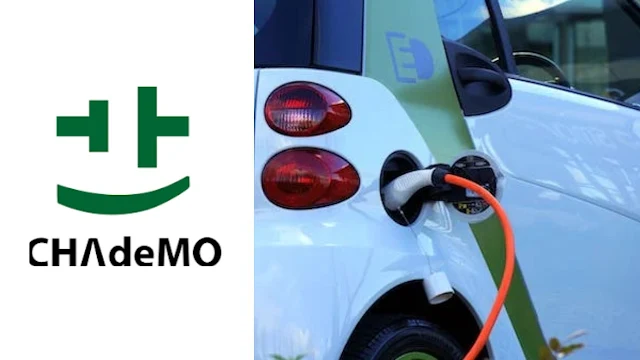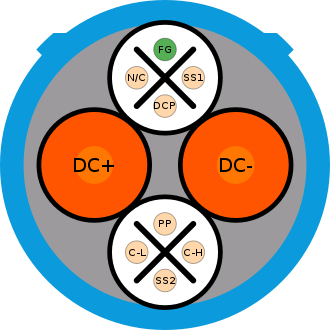What is Chademo?
Chademo which stands for Charge de Move is a fast DC charging standard for electric vehicles (EVs) that is developed by the CHAdeMO Association. It originated in Japan and gain international recognition as a widely used DC fast-charging protocol.
The Chademo protocol allows for high-power charging of electric vehicles by utilizing a direct current connection. It uses a specific type of connector that plugs into the vehicle's charging inlet port and the charging station. The connector typically has both power and communication pins, enabling data exchange between the vehicle and the charger.
One of the significant advantages of Chademo is its ability to provide high charging power, allowing for rapid charging of EVs. The charging power can range from 50 kilowatts (kW) up to 200 kW or more, depending on the capabilities of the charging station and the vehicle being charged.
Chademo was one of the earliest fast-charging standards to be widely deployed, primarily in Japan but also in other regions such as Europe, the United States, and several Asian countries. However, it has faced competition from other fast charging standards like CCS i.e. Combined Charging System which has gained more popularity in recent years due to its broader industry support and compatibility with both AC and DC charging.
Development of Chademo
The history of Chademo dates back to the early 2000s when several Japanese companies came together to develop a standardized fast-charging protocol for electric vehicles. Then Chademo Association was established in 2010 to further promote and support the technology for fast charging of EVs.
In 2008 the Japanese companies Tokyo Electric Power Company (TEPCO), Nissan, Mitsubishi, and Fuji Heavy Industries (now known as Subaru) collaborated to develop a fast charging system for electric vehicles. This led to the creation of the Chademo protocol.
In 2010 the Chademo Association was formed with the aim of promoting the Chademo protocol and expanding its adoption. The association consisted of various stakeholders, including automakers, electric utilities, charging station manufacturers, and academic institutions. In 2011 the first Chademo-compatible electric vehicles, such as the Nissan Leaf and Mitsubishi i-MiEV, were introduced to the market. This marked the beginning of the widespread deployment of Chademo charging infrastructure in Japan.
In 2012 the Chademo Association launched the CHAdeMO 1.0 specification, which defined the technical standards for the charging protocol. This version supported charging power levels of up to 50 kW. In 2014 the Chademo 2.0 specification was released, introducing improvements to the protocol. It increased the charging power to 100 kW and enabled bi-directional power flow, allowing electric vehicles to supply power back to the grid which is known as vehicle-to-grid or V2G technology.
In 2017 Chademo 3.0 was announced, raising the charging power to 400 kW and introducing a more compact connector design. This version aimed to compete with other fast charging standards like CCS.
In 2018 the Chademo Association and the CharIN (Charging Interface Initiative) consortium, which promotes CCS, announced a collaboration to develop a next-generation, universal fast-charging standard that would incorporate the best features of both Chademo and CCS. This initiative aimed to address interoperability challenges and promote a more unified charging infrastructure.
Since then, Chademo has continued to evolve, with ongoing developments in both the protocol and charging infrastructure. While its market share has faced some challenges from competing standards, Chademo charging stations can still be found in various regions, particularly in Japan, and many electric vehicles support Chademo charging.
Connector of Chademo
The Chademo connector features a unique design that facilitates high-power charging of electric vehicles (EVs) using the Chademo fast charging protocol. Description of its design is :Shape and Size
The connector has a rectangular shape with rounded edges. It is larger and bulkier compared to some other connector types. The size of the connector is determined by the various pins and sockets it contains for power transmission and data communication.
Housing Material
The connector housing is typically made of durable and heat-resistant materials such as high-grade plastics or composite materials. These materials ensure the connector's longevity and ability to withstand the rigors of frequent charging.
Power Pins
The connector has two large power pins, known as the "DC+" and "DC -" pins. These pins carry the high-current (DC) power that is required for fast charging. They are thicker and sturdier than the communication pins to handle higher power levels.
Communication Pins
In addition to the power pins, the Chademo connector incorporates several smaller pins for communication purposes. These pins are responsible for data exchange between the EV and the charging station. They enable functions such as monitoring the charging process, controlling the charging parameters, and ensuring safe charging operations.
Locking Mechanism
The Chademo connector features a robust locking mechanism to ensure a secure and stable connection during charging. It typically employs a lever or button mechanism that needs to be pressed to release the connector from the charging port. The locking mechanism prevents accidental disconnection, especially when the EV is being charged.
Labeling and Color Coding
The Chademo connector often includes clear labeling and color coding to assist users in identifying the correct orientation and connection points. The labels may indicate the positive and negative terminals, as well as other symbols or indicators for proper usage.
Regional Variations:
While the fundamental design of the Chademo connector remains consistent, there have been some regional variations in its physical appearance and pin arrangements. For example, the Japanese version of the Chademo connector may differ slightly from the European or American versions. However, these variations are generally compatible, allowing for international EV charging.
Charging Process of EV By Chademo
The charging process of a Chademo fast charger involves several steps to efficiently and rapidly charge EVs that are compatible with the Chademo protocol. Here charging processes of EVs are given :Connection
The EV driver connects the Chademo connector from the charging station to the vehicle's Chademo charging port. The connector is securely locked into place using the built-in locking mechanism.
Initial Communication:
The charging station and the EV establish communication to exchange information and ensure compatibility. This communication includes authentication, where the charging station verifies the EV's eligibility for charging.
Power Supply:
Once the connection and communication are established, the charging station supplies the required electrical power to the EV. The Chademo charger provides a high-power direct current (DC) supply to charge the vehicle's battery.
Charging Control
The charging station monitors and controls the charging process. It continuously communicates with the EV to regulate the charging parameters such as voltage, current, and charging rate. This communication ensures safe and optimized charging based on the EV's capabilities and battery condition.
Battery Charging
The EV's onboard charger converts the incoming high-power DC supply from the charging station into the appropriate voltage and current to charge the vehicle's battery. The Chademo charging process supports high charging power, allowing for rapid replenishment of the battery capacity.
Charging Progress and Feedback:
During the charging process, the charging station provides real-time feedback on the charging progress. It may display the charging rate, remaining charging time, or battery state of charge (SOC) to the user. This information allows the driver to monitor the charging status.
Charging Completion
Once the EV's battery reaches the desired SOC or the charging session duration is complete, the charging station stops the power supply. The user can then disconnect the Chademo connector from the vehicle's charging port.
Advantages and Disadvantages of Chademo
Advantages of Chademo
Early Adoption: Chademo was one of the earliest fast-charging standards to be widely deployed. This early adoption led to a significant number of Chademo charging stations being available, particularly in Japan, offering convenience to Chademo-compatible EV owners.High Charging Power: Chademo supports high charging power levels, allowing for rapid charging of electric vehicles. Charging power can range from 50 kW up to 200 kW or more, depending on the capabilities of the charging station and the vehicle.
Established Infrastructure: Chademo has an established charging infrastructure in many regions, particularly in Japan. This infrastructure can provide reliable charging options for EV owners, enabling long-distance travel and reducing range anxiety.
Bidirectional Charging: Chademo supports bidirectional charging, also known as vehicle-to-grid (V2G) technology. This allows EVs to not only receive power from the grid but also supply power back to the grid, enabling potential benefits such as energy storage and grid stabilization.
Disadvantages of CHAdeMO:
Regional Limitations: While Chademo has gained international recognition, its deployment has been more concentrated in specific regions. In some areas, such as North America and parts of Europe, Chademo infrastructure may be less prevalent compared to other fast charging standards like CCS (Combined Charging System).
Limited Industry Support: Chademo has faced competition from other fast-charging standards, notably CCS. CCS has gained broader industry support, including automakers and charging infrastructure providers, leading to its wider adoption in recent years.
Connector Compatibility: Chademo connectors have gone through iterations and variations across different regions, leading to some compatibility challenges between different versions. While efforts have been made to ensure backward compatibility, there may be instances where certain Chademo chargers or vehicles may not be fully compatible with each other.
Charging Speed Competition: With the advent of newer charging technologies and standards, such as ultra-fast DC charging options, Chademo's charging speeds, although high, may be comparatively slower than the latest charging standards, limiting its competitiveness in the evolving EV market.
Chademo Charger Communication Pin Description
The above-given figure is a cross-sectional view of the Chademo charger pin. From the figure, it is clear that there are 10 pins used Chademo charger. These pins have different functions during the charging process.
Role of FG
This pin is a ground pin and is used as a reference pin for all other communication pins.
SS1 / SS2
These two pins are known as charge sequence signal pins and are used to either start charging or stop charging processes.
N/C
It means not connected. This pin generates a signal when the connector is not connected properly to the vehicle.
DCP
This pin is used to enable charging. it generates a signal to the charger to start delivering power to EV.
DC+ / DC-
These pins are known as power pins. High electric dc power start flowing from the charger to EV by these two pins.
PP
This pin is known as a proximity pilot. This pin is used to check the locking of the connector and the capability of the cable.
C-H / C-L
This pin is used to share battery parameters like voltage, SOC, Current, temperature, etc with the charger.

